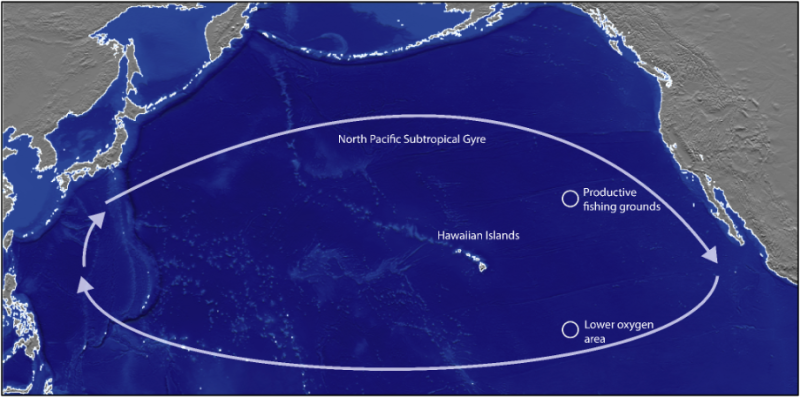On June 9, the NOAA Ship Oscar Elton Sette will depart Hawai‘i for a month-long mission to study a remote area of the North Pacific Ocean. Scientists from the Pacific Islands Fisheries Science Center will study the ecosystem. They will investigate its smallest inhabitants, marine bacteria and phytoplankton (microscopic plants), all the way to the animals that serve as prey for bigeye tuna, such as lanternfish and squid. The goal is to understand what makes an area good or bad habitat for bigeye tuna and how that environment might change in a changing climate.
The North Pacific Subtropical Gyre, the largest ecosystem on earth, supports a host of marine life. They include everything from oxygen-producing marine bacteria and phytoplankton to highly mobile apex predators like tunas, whales, and sharks. Across the boundaries of the gyre, there are distinct differences in oceanographic properties such as temperature, nutrients, and oxygen content. Scientists don’t fully understand how these differences influence highly mobile fish like bigeye tuna. This research expedition sets out to investigate these characteristics in an area to the east of Hawai‘i, about halfway to California. The edge of the gyre is likely to shift as a result of global climate change. Understanding the ecosystem there should allow scientists to better understand how it might change in the future.
During the project, scientists will collect chemical and physical oceanographic data. They will also gather biological information by sampling environmental DNA, bacteria, and phytoplankton directly from the water. They will use a variety of nets to collect zooplankton, fish larvae, and daily migrating micronekton. These are smaller pelagic organisms, approximately 1–6 inches in length, made up mainly of crustaceans, fish, and squid. By studying all aspects of the ecosystem, scientists hope to gain a better understanding of why certain areas are better fishing grounds than others.
Scientists at the Pacific Islands Fisheries Science Center have shown that the quality of food available to newly hatched and larval bigeye tuna is a good predictor of the future tuna catch. Building on that research, this expedition will also measure the size and type of zooplankton and micronekton. They will analyze the stomach contents of the micronekton to determine their diet. At the same time, the scientists will collect environmental DNA to estimate the species composition of the whole ecosystem, from microbes to megafauna, providing a snapshot of the inhabitants of the ocean at a specific place and point in time. By looking at the ocean environment together with all the different layers of the food web, scientists can gain a better understanding of the ecosystem that supports bigeye tuna and how to best manage that ecosystem for the future.
“This research expedition will sail to one of the most remote areas in the North Pacific Ocean to study an area that is increasingly important to the bigeye tuna fishery but is poorly studied due to its remoteness,” says Johanna Wren, the lead scientist with NOAA’s Pacific Islands Fisheries Science Center. “And just to the south is an area where there is no fishing activity, likely because bigeye tuna don’t spend much time there. We want to understand why that is, and how that pattern—really productive areas to the north and poor habitat to the south—will shift with climate change.”
The outcome of this expedition will offer a unique look into a large part of the ecosystem at one point in time, which is very rare. Until now, scientists have had to rely on data collected from many different sources that don’t always cover the same timeframe to study the ecosystem. Now, scientists will have physical, biogeochemical, and ecological data from the same place at the same time, allowing them to examine the interplay between the bottom of the food web all the way to the top predators.

